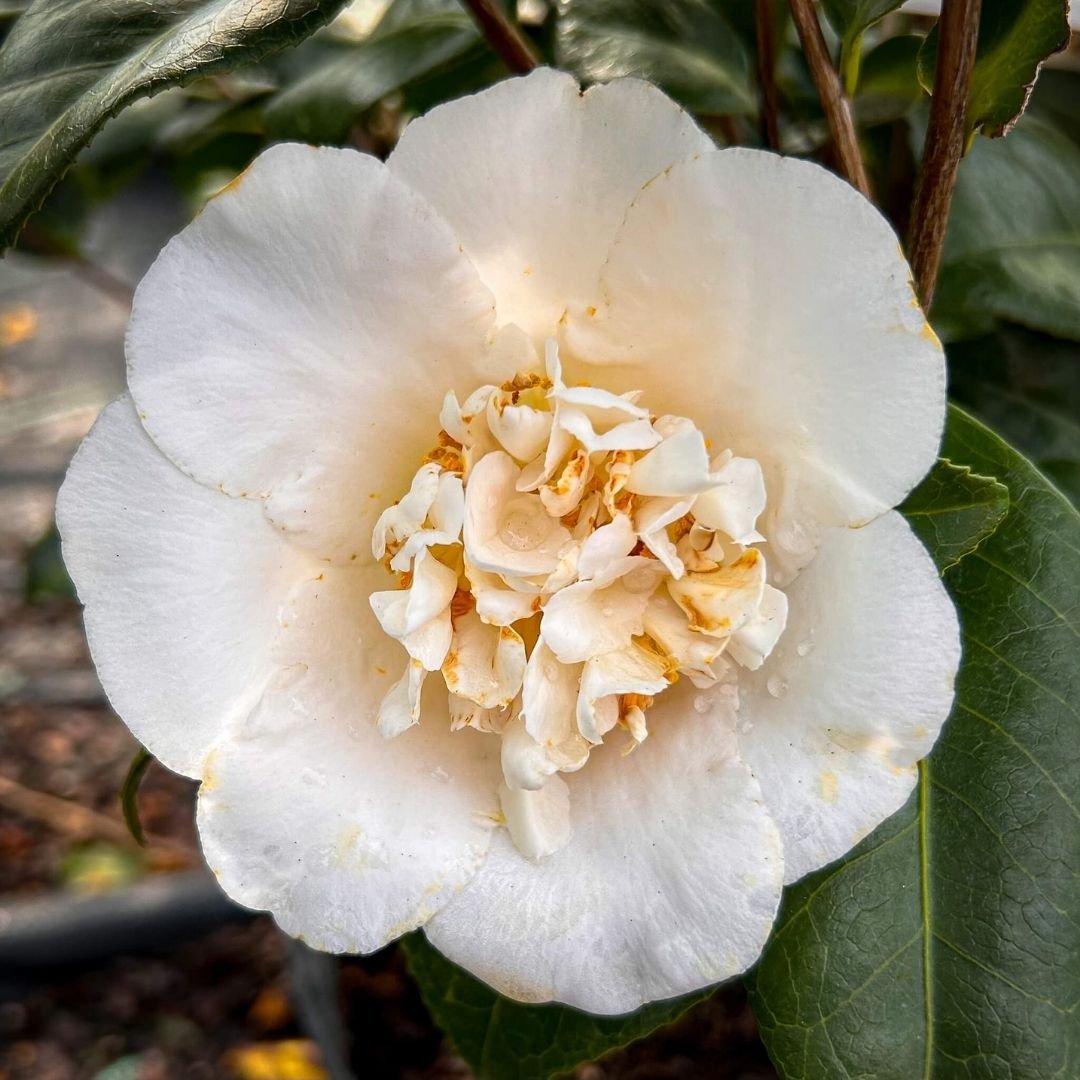Snow Chan Camellia: Winter Blooming Evergreen Shrub
Large, Pure White Flowers
The Snow Chan Japanese camellia (Camellia japonica ‘Snow Chan’) is a slow growing evergreen shrub with pure white flowers and dark glossy foliage.
Snow Chan blooms from autumn through late winter, when many other plants are dormant.
The 4-6 inch wide anemone-form flowers have pure white petals surrounding a glowing golden center.
This camellia variety is hardy in zones 7-9 and flowers abundantly from autumn through late winter, bringing a dash of elegance to the winter garden at a time when little else is blooming.
Snow Chan is a sport of the Shiro Chan Japanese camellia (a sport is an accidental genetic mutation that produces an offspring with distinct differences in appearance and genetic makeup).
It was introduced by Nuccio’s Nurseries in 1957, and is also known by the synonyms ‘White Elegans’ and ‘Xeuchan’.
Snow Chan has a slower growth rate and more open habit than other Japanese camellias, eventually reaching a mature size of 8-10 feet tall and maintaining a rounded, even habit.
Traditionally associated with Japan, where they grow wild on shady hillsides, Japanese camellias (called “Tsubaki” in Japanese) are deeply rooted in the history, culture and art of Asia, with a lineage dating back over a thousand years (read about Goto’s 400 year-old camellia trees).
Symbolizing longevity, purity and love, the glossy leaves and vibrant blossoms of the camellia have adorned the gardens of temples, imperial palaces, and samurai residences.
Oil from the camellia’s ripened fruit has been used for centuries for cooking, tea, cosmetics and hair products.
Today, the camellia continues to be cherished in Asia, not only for its aesthetic charm but as a living symbol that intertwines the past with the present day.
Japanese camellias have found a welcoming home in the southern regions of the United States, where their glossy evergreen leaves and vibrant blooms thrive in the milder gardening zones of 7, 8 and 9.
Keep scrolling to learn how to grow and care for this classic camellia, plus get some tips for finding the perfect site and ideas for picking the best planting companions.
The Snow Chan Japanese Camellia
How To Find the Perfect Site for Your Camellia
Camellias like moist, well-drained, acidic soil. They are sensitive to high pH soils (alkaline), which will turn their leaves yellow.
If you are not sure about your soil conditions, do a soil test before investing in a camellia plant.
Partial shade is best for these evergreen shrubs, and they appreciate being kept out of the hot afternoon sun.
Site them in an area where they receive protection from drying winds.
Amend the soil heavily with organic matter such as compost or shredded leaves.
Are Camellias Deer-Resistant?
Camellias are considered to be a deer-resistant plant. They are not a preferred choice for deer to browse, since deer find their thick glossy green leaves unappetizing.
Unfortunately, no plant is 100% deer proof 😞. Deer will eat almost anything, especially during times of drought or in areas with high deer populations and intense competition for food.
When resources are scarce, they expand their diet beyond their usual preferences, browsing on plants they might normally avoid.
So, deer may occasionally browse camellias, especially the buds of tender young plants.
To protect new plantings, use wire fencing, chicken wire or other barriers until your camellias are larger and well established.
How to Plant and Grow the Snow Chan Japanese Camellia
Location: Choose a site with well-drained, slightly acidic soil. Japanese camellias prefer partial shade to protect them from the intense afternoon sun.
Wind Protection: Plant Japanese camellias in an area where they are sheltered from strong, drying winds.
Soil: Amend the soil with organic matter, such as compost, shredded leaves, or Leaf-gro®, to improve drainage and soil fertility. Ensure that the soil pH is slightly acidic - the best soil pH for camellias is in the range of 6.0 to 6.5.
Mulch: Apply a layer of organic mulch around the base of the plant to retain soil moisture, regulate temperature, and suppress weeds.
Watering: Keep the soil consistently moist but not waterlogged, especially during periods of drought. Deep watering is preferable to encourage the development of a strong root system. For more information on watering, see “How to Water your Plants”.
Fertilization: In spring, after flowering, feed camellias with a balanced, slow-release fertilizer formulated for acid-loving plants (like Holly-tone®). Avoid excessive use of high-nitrogen fertilizers.
Pruning: Prune Japanese camellias sparingly to shape the plant and remove dead or damaged branches. The best time for pruning is after the plant has finished flowering.
Monitor for Insects and Disease: Camellias have the potential to be long-lived plants, yet they can suffer from a number of different fungal diseases and scale insects. Keep an eye on your camellias, and be proactive as soon as you notice any sign of trouble.
Is the Snow Chan Japanese Camellia Hard to Grow?
Japanese camellias are known for their relatively easy care, provided they are planted in the right location. The key to successful cultivation lies in selecting an appropriate site that meets their specific needs. To create the ideal environment:
Plant in partial shade
Avoid direct exposure to intense afternoon sunlight
Protect from drying winds
Avoid planting in alkaline soils (perform a soil test, if needed)
Amend the soil with organic matter, such as compost, Leaf-gro®, or shredded leaves.
If you are not able to provide a Japanese camellia with the conditions it requires to thrive, consider these alternatives:
Sansaqua camellia (Camellia sansaqua): A cousin to the Japanese camellia, this flowering evergreen shrub can handle more sun and slightly acidic to neutral soil.
Pink Icicle camellia (Camellia ‘Pink Icicle’): A hybrid camellia bred to withstand colder temperatures (up to -5°F) yet still be able to produce beautiful flowers.
American Holly (Ilex opaca): An upright, pyramidal evergreen shrub to small tree with red berries and green leaves. It grows in full sun to part shade; the boughs make excellent holiday decorations.
Yaupon Holly (Ilex vomitoria): An evergreen shrub or small tree with bright red berries and glossy green leaves. A relatively long-lived plant that tolerates full sun to full shade.
Summersweet clethra (Clethra alnifolia): A tall shrub with white, bottlebrush-shaped summer flowers in full sun to shade. Straight species grows to 8 feet tall; smaller cultivars available.
Mountain hydrangea (Hydrangea serrata): An easy-care shrub for partial shade, with lacy flat-topped flowers in the summer. Grows to 5 feet tall; smaller cultivars available.
What is Wrong with My Japanese Camellia?
Yellowing leaves could be due to various factors, including nutrient deficiencies (especially iron in alkaline soils), poor drainage, or overwatering.
Brown, crispy leaf edges can be caused by underwatering, excessive sunlight, or windburn.
Leaf drop is caused by stress from sudden environmental changes, pests, or disease.
Bud drop before blooming can be caused by drought, sudden temperature fluctuations, or insufficient sunlight (Are you in a drought? Check the U.S. Drought Monitor).
Black or brown spots on the leaves and be caused by fungal infections.
Stunted growth can be a result of poor soil conditions, a lack of nutrients, or siting in an unsuitable location.
Why is My Japanese Camellia Turning Yellow?
The yellowing of leaves on a Japanese camellia can be attributed to several different factors. Here are some common reasons why your camellia leaves may be turning yellow:
Nutrient Deficiency: Camellias are sensitive to iron deficiency, especially in alkaline soils. This can result in yellowing leaves with green veins (chlorosis). Consider applying a fertilizer specifically formulated for acid-loving plants, which includes micronutrients like iron.
Improper Soil pH: Camellias prefer slightly acidic soil, with a pH of 6.0-6.5. If the pH is too high (alkaline), it can affect nutrient availability, leading to yellowing leaves. Test the soil pH and, if necessary, amend it with materials to lower the pH, like aluminum sulfate or sulfur.
Overwatering or Poor Drainage: Excessive soil moisture can lead to root rot, causing leaves to yellow. Ensure proper drainage and avoid overwatering - camellias prefer consistently moist but not waterlogged soil.
Sun Exposure: Too much direct sunlight, especially in the hot afternoon hours, can cause leaf scorching and yellowing. Ensure your camellia is planted in partial shade.
Pests and Diseases: Pests and fungal diseases can cause yellowing of leaves. Check the undersides of leaves for signs of pests and treat accordingly; ensure good air circulation and proper watering practices to prevent fungal issues.
Transplant Shock: Recently planted camellias may experience stress from transplant shock, causing the leaves to yellow. Ensure new transplants receive adequate water and time to recover.
Planting Companion Ideas
Flaming Silver Japanese Andromeda (Pieris japonica ‘Cavatine’)
Haas’ Halo Lacecap Hydrangea (Hydrangea arborescens ‘Haas’ Halo’)
Duke Gardens Plum Yew (Cephalotaxus harringtonia ‘Duke Gardens’)
Sweet Talker® Fragrant Viburnum (Viburnum ‘NCVX4’)
Stonehenge Dark Druid® Yew (Taxus x media 'SMNTHDB')
Fizzy Mizzy® Virginia Sweetspire (Itea virginica 'SMNIVMM')
Summersweet (Clethra alnifolia)
Light-O-Day® Hydrangea (Hydrangea macrophylla ‘BAILDAY’)
Dwarf Fothergilla (Fothergilla gardenii)
Delaware Valley White Azalea (Rhododendron ‘Delaware Valley White’)
Flame Azalea (Rhododendron calendulaceum)


